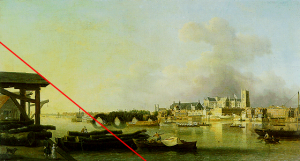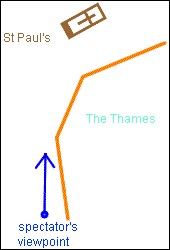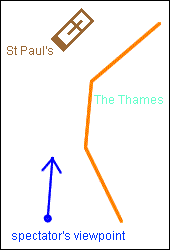Depth of field and variations on the viewpoint
Depth of field
The art of townscape raises geometrical problems of spatial rendering which involve options in the depth of field between the distances. The main focusing may be on the foreground, with low depth of field and muted recession effects, avoiding the distortion which would be caused by accelerated perspective.
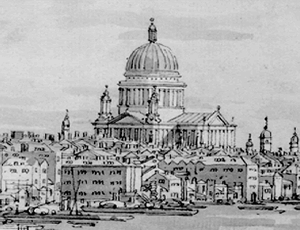
- Canaletto, The City of London
- drawing (details, The Royal Collection © 2000 Her Majesty Queen Elizabeth II)
[click on the picture to enlarge it]
The drawing shows the dome of St Paul’s with the horizontal lines in the drum of the dome projected as straight lines, supposing the spectator’s viewpoint at the same level, and also making the curvature negligible under the effect of distance, due to the low depth of field. The foreground takes on more importance, in full light and with emphasised landing steps, making the middle distance recede.
Another drawing is taken from a slightly different angle.
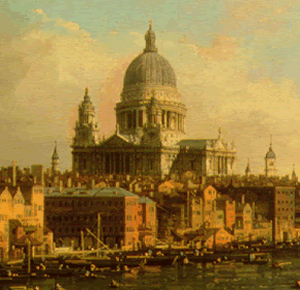
- Canaletto, The City of London
- painting (details, The Royal Collection © 2000 Her Majesty Queen Elizabeth II)
[click on the picture to enlarge it]
In the painting, the base of the dome is projected as an ellipse , implying a lower spectator viewpoint which emphasises the perspective contrast between the distances. The foreground filled with air and water only guides the viewer’s gaze towards the middle distance.
This effect is combined with a variation on the viewpoint, as shown in the animation.
The two bridges, London Bridge and Westminster Bridge, were frequently painted.
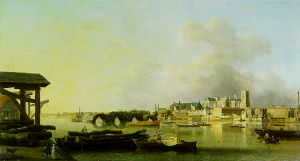
- Samuel Scott, Westminster Bridge
- (1748-49, The Governor and Company of the Bank of England)
[click on the picture to enlarge it]
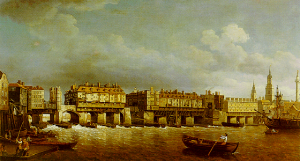
- Samuel Scott, London Bridge
- (1748-49, The Governor and Company of the Bank of England)
[click on the picture to enlarge it]
Samuel Scott painted two views of the Thames from two distinct positions, which broadens the field of vision.
He combines spatial breadth with depth of field, using the foreground in Westminster Bridge where the timber yard is a
He also used framing effects.

- Canaletto, drawing for A View of the City from Somerset House
- (drawing, c. 1746, Courtauld Institute)
[click on the picture to enlarge it]
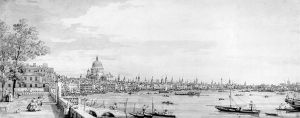
- Canaletto, drawing for A View of the City from Somerset House
- (The Royal Collection © 2000 Her Majesty Queen Elizabeth II)
[click on the picture to enlarge it]
A comparison between the two drawings shows that they are taken from slightly different viewpoints.
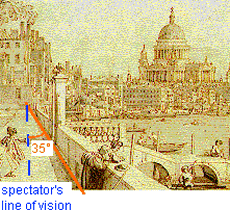
- detail of the drawing in the Courtauld Institute
In the Courtauld drawing, the low wall along the terrace makes a small angle with the vertical (about 35°), supposing the spectator close to it and to the woman bending over it; the West front of St Paul’s is seen obliquely in foreshortening.
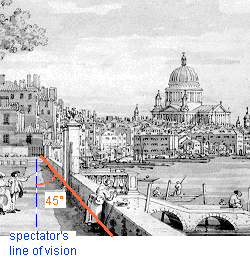
- detail of the drawing in the Royal Collection
In the Royal Collection drawing, it makes an angle of about 45°, supposing the spectator more to the left, seeing the West Front of St Paul’s in a more frontal view.
Variation of viewpoint
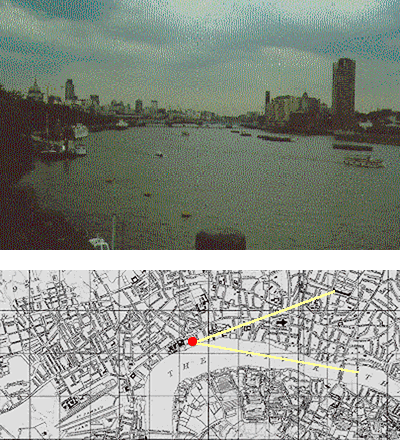
- Variation of viewpoint
- [click on the picture to enlarge it]
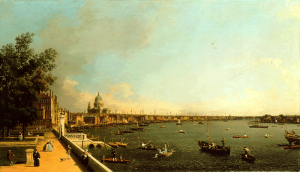
- Canaletto, Two Views from the Terrace of Somerset House : The City of London and the City of Westminster
- (c.1750, The Royal Collection (c) 2000 Her Majesty Queen Elizabeth II)
[click on the picture to enlarge it]
From the terrace of Somerset House, St Paul’s appears just above the margin between the Thames and houses (even in the 18th century, before the building of the Embankment) whereas in the painting, St Paul’s appears above an expanse of water, as if the view were taken from further upstream after the curve of the Thames (as in Canaletto’s earlier view from Richmond House) ; the effect is emphasized by the highlights on the water. This causes an oscillation between two points of view in the spectator’s eye.

